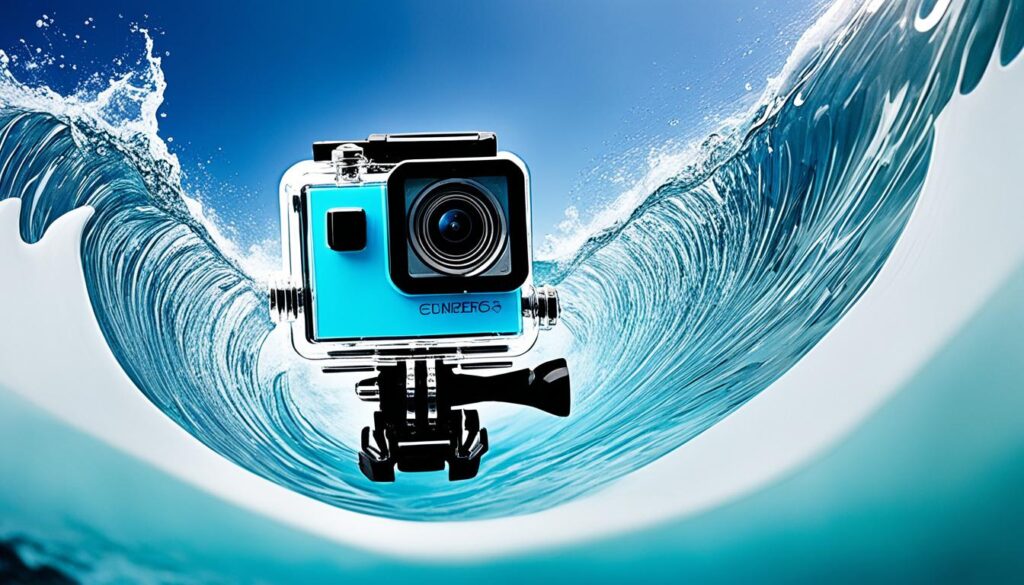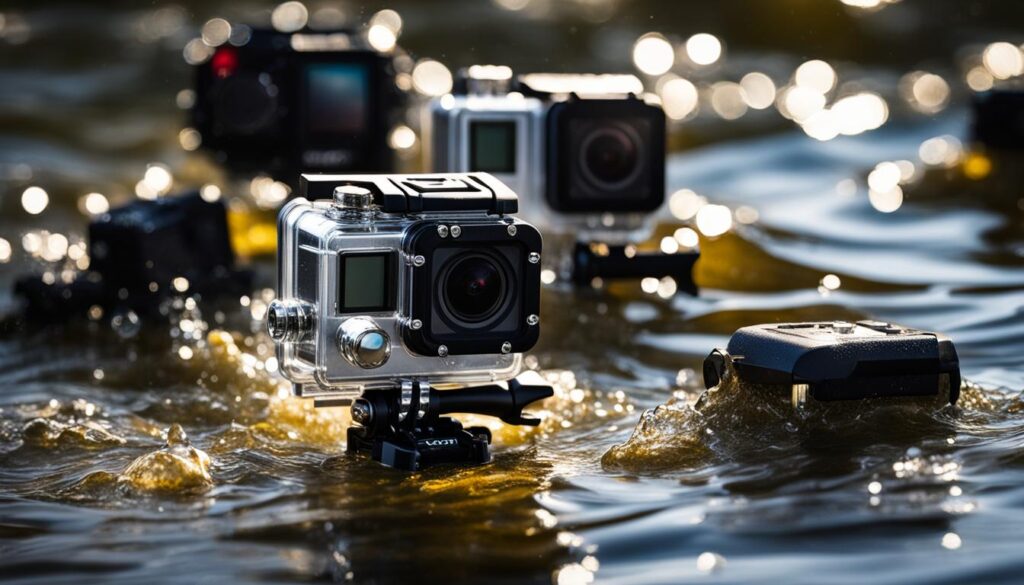
Are you ready to dive into action and capture thrilling moments with your helmet cam? Whether you’re exploring underwater caves, taking on towering waves, or enjoying a refreshing swim, it’s crucial to have a waterproof camera that can handle the challenge. But how do you ensure your camera is truly built to withstand extreme water pressure and capture every breathtaking moment? Discover the top waterproofing tips for your action camera to protect your gear and seize the adventure without worries.
Key Takeaways:
- Waterproof action cameras have evolved with advanced technology to endure various water activities.
- Factors like design, sealing, depth rating, temperature, and maintenance affect the waterproofing capabilities of action cameras.
- Some of the best waterproof action cameras in the market include GoPro Hero9 Black, DJI Osmo Action, Sony RX0 II, Olympus Tough TG-6, and AKASO Brave 7 LE.
- Regular maintenance and care are vital to keep your waterproof action camera in optimal condition.
- By following these waterproofing tips, you can confidently capture your water sports adventures and protect your gear.
Factors Affecting Waterproofing in Action Cameras
When it comes to action cameras, their ability to withstand water and other harsh conditions is a crucial feature. However, several factors influence the waterproofing capabilities of these cameras. Here, we’ll explore the key elements that impact their waterproof performance: design, sealing, depth rating, temperature, and maintenance.
Design
The design of an action camera plays a significant role in its waterproofing capabilities. Cameras specifically designed for underwater use are more likely to be fully waterproof. These models often feature specialized coatings, reinforced casings, and secure seals to protect the internal components from water damage.
Sealing
The effectiveness of the camera’s sealing is another critical factor. Cameras with better sealing are less likely to allow water to enter, ensuring their internal components remain protected. High-quality seals around the camera’s body and ports are crucial for maintaining waterproof integrity.
Depth Rating
The depth rating of an action camera indicates the maximum depth at which it can be used without the risk of water damage. Cameras with higher depth ratings can be safely used at greater depths, making them suitable for various underwater activities such as diving and snorkeling. It’s important to check the manufacturer’s specifications to ensure the camera meets your depth requirements.
Temperature
Extreme temperatures can affect the performance of waterproof action cameras. Seals may expand or contract under extreme heat or cold, causing them to fail and potentially allowing water to enter. It’s essential to use the camera within the recommended temperature range to maintain its waterproof capabilities.
Maintenance
Proper maintenance is vital for preserving the waterproofing of action cameras. Regular cleaning and inspection of seals help identify any signs of wear or damage, allowing timely repairs or replacements. Following the manufacturer’s maintenance guidelines, such as proper rinsing and drying after each use, helps prevent the buildup of contaminants that can compromise the camera’s waterproof integrity.
By considering the design, sealing, depth rating, temperature, and maintenance of action cameras, users can ensure their devices remain waterproof and ready for any water adventure.
Best Waterproof Action Cameras in the Market
When it comes to capturing your adventures in water, having a reliable waterproof action camera is essential. Let’s explore some of the top contenders in the market:
1. GoPro Hero9 Black
- Waterproof capabilities up to 33 feet
- Impressive 5K resolution

2. DJI Osmo Action
- Waterproof capabilities up to 36 feet
- Stunning image quality
3. Sony RX0 II
- Waterproof capabilities up to 33 feet
- Compact and rugged design
4. Olympus Tough TG-6
- Waterproof capabilities up to 50 feet
- Built to withstand tough conditions
5. AKASO Brave 7 LE
- Waterproof capabilities up to 131 feet
- Highly versatile and feature-packed
These waterproof action cameras offer a range of features and capabilities to suit different needs. Whether you’re an avid water sports enthusiast or simply looking to capture your beach adventures, these cameras have got you covered. Just remember to choose the one that best fits your requirements and dive into your next underwater escapade with confidence!
Maintenance and Care for Waterproof Action Cameras
Proper maintenance and care are crucial to ensure the longevity of waterproof action cameras. By following these essential tips, you can protect your camera and keep it in excellent working condition.
Rinsing and Drying
After each use in saltwater or chlorinated water, it’s important to rinse the camera with fresh water. This helps remove any harmful residue and prevents corrosion. Pay extra attention to ports and compartments, ensuring they are thoroughly rinsed. Once rinsed, dry the camera completely before opening any ports or compartments. Use a soft cloth or towel to absorb moisture, and avoid using excessive heat sources that may damage the camera.
Protecting from Extreme Temperatures
Keep your camera away from extreme temperatures and direct sunlight to prevent damage. Exposure to high temperatures can cause seals to deteriorate, compromising the camera’s waterproofing ability. It’s recommended to store your camera in a cool, dry place when not in use.
Using a Protective Case or Housing
In rough conditions or during extreme water activities, it’s advisable to use a protective case or housing for your camera. These accessories add an extra layer of protection, safeguarding your camera against impacts and ensuring its waterproofing capabilities are maintained.
Regular Seals and Gaskets Check
Regularly inspect the seals and gaskets of your camera for wear or damage. Over time, these components may deteriorate and compromise the camera’s waterproofing. If you notice any signs of wear, it’s essential to replace them promptly or consult a professional for assistance. Following the manufacturer’s instructions for seal maintenance and replacement is crucial for optimal waterproofing performance.
Battery Care and Charging
Follow the manufacturer’s instructions for battery care and charging. Improper battery handling can lead to damage, which could affect the camera’s overall performance, including its waterproofing. Always use the recommended charging cables and avoid overcharging or exposing the camera to excessive heat while charging.
By adhering to these maintenance and care guidelines, you can ensure your waterproof action camera remains in top condition, allowing you to capture your underwater adventures without any worries.

Conclusion
When it comes to using helmet cameras in water sports, waterproofing tips are essential. Understanding the technology and factors that affect waterproofing can help ensure the longevity of your camera. Investing in a reliable waterproof action camera and following proper maintenance and care guidelines is key to protecting your gear and ensuring optimal performance.
By taking the right precautions and implementing effective waterproofing measures, adventurers can capture their thrilling water sports adventures while keeping their equipment safe and durable. With the ever-evolving advancements in waterproofing technology, the market offers a range of top-quality helmet cameras suitable for various water sports activities.
Remember to choose a helmet camera that is specifically designed for the water sports you enjoy and offers a high level of waterproofing. Regularly check and maintain the seals, gaskets, and other components to prevent any potential water damage. Rinse the camera with fresh water after use in saltwater or chlorinated water, and ensure it is thoroughly dried before opening any ports or compartments.
Shielding your gear from extreme temperatures, direct sunlight, and rough handling can further enhance its durability. And don’t forget to store the camera in a dry, cool place when not in use. By following these waterproofing tips and taking proper care of your helmet camera, you can confidently capture unforgettable moments and protect your valuable gear.
Source Links
- https://www.kentfaith.com/blog/article_can-any-action-camera-waterproof_14068
- https://www.techradar.com/news/best-action-camera
- https://www.wired.com/gallery/best-action-cameras/

Meet James Smith, affectionately known by friends as ‘Biker Smith’, your go-to expert at ‘Best HD Helmet Camera’. At 35, living in the USA, James embodies the spirit of adventure. His life is a thrilling ride, powered by his Harley Davidson Softail and BMW S 1000 RR, with his girlfriend as his favorite travel companion. A software developer by profession, James’s heart beats for the open road, making him a full-time traveler at heart. His passion for biking and technology merges seamlessly on this platform. Recognizing a gap in discussions around helmet cameras, he founded this blog to educate and inspire fellow enthusiasts. His mission? To elevate your riding experience with the best HD helmet camera insights, backed by firsthand experiences, rigorous testing, and a genuine love for the ride. Trust James to guide you through the world of helmet cameras, where quality, innovation, and safety ride together.